YAMAHA TTR50 2015 Manual PDF
Manufacturer: YAMAHA, Model Year: 2015, Model line: TTR50, Model: YAMAHA TTR50 2015Pages: 86, PDF Size: 1.87 MB
Page 71 of 86
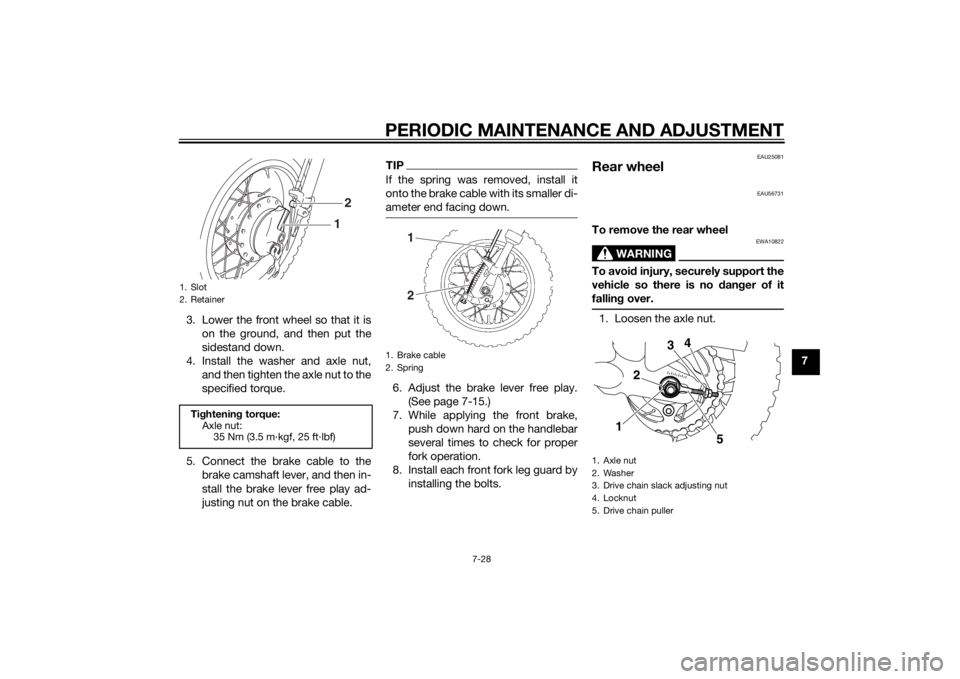
PERIODIC MAINTENANCE AND ADJUSTMENT
7-28
7
3. Lower the front wheel so that it is
on the ground, and then put the
sidestand down.
4. Install the washer and axle nut, and then tighten the axle nut to the
specified torque.
5. Connect the brake cable to the brake camshaft lever, and then in-
stall the brake lever free play ad-
justing nut on the brake cable.
TIPIf the spring was removed, install it
onto the brake cable with its smaller di-
ameter end facing down.6. Adjust the brake lever free play.(See page 7-15.)
7. While applying the front brake, push down hard on the handlebar
several times to check for proper
fork operation.
8. Install each front fork leg guard by installing the bolts.
EAU25081
Rear wheel
EAU56731
To remove the rear wheel
WARNING
EWA10822
To avoi d injury, securely support the
vehicle so there is no dan ger of it
fallin g over.1. Loosen the axle nut.
1. Slot
2. RetainerTi ghtenin g torque:
Axle nut: 35 Nm (3.5 m·kgf, 25 ft·lbf)
2
1
1. Brake cable
2. Spring
12
1. Axle nut
2. Washer
3. Drive chain slack adjusting nut
4. Locknut
5. Drive chain puller
1
5
4
3
2
U2CJ82E0.book Page 28 Monday, June 23, 2014 2:58 PM
Page 72 of 86
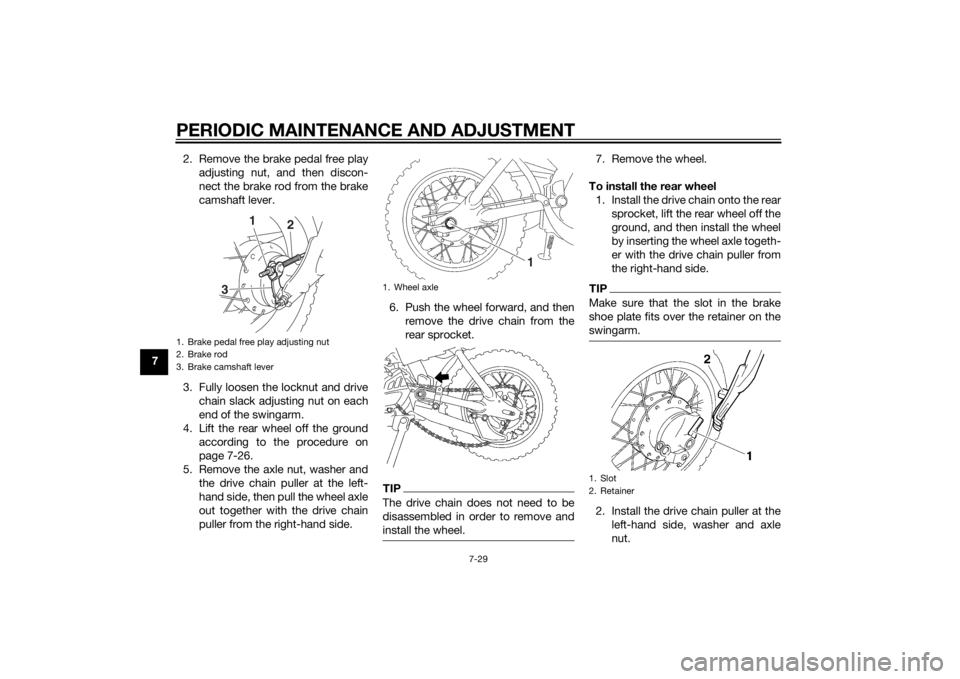
PERIODIC MAINTENANCE AND ADJUSTMENT
7-29
72. Remove the brake pedal free play
adjusting nut, and then discon-
nect the brake rod from the brake
camshaft lever.
3. Fully loosen the locknut and drive chain slack adjusting nut on each
end of the swingarm.
4. Lift the rear wheel off the ground according to the procedure on
page 7-26.
5. Remove the axle nut, washer and the drive chain puller at the left-
hand side, then pull the wheel axle
out together with the drive chain
puller from the right-hand side. 6. Push the wheel forward, and then
remove the drive chain from the
rear sprocket.
TIPThe drive chain does not need to be
disassembled in order to remove and
install the wheel.
7. Remove the wheel.
To install the rear wheel 1. Install the drive chain onto the rear sprocket, lift the rear wheel off the
ground, and then install the wheel
by inserting the wheel axle togeth-
er with the drive chain puller from
the right-hand side.TIPMake sure that the slot in the brake
shoe plate fits over the retainer on the
swingarm.2. Install the drive chain puller at theleft-hand side, washer and axle
nut.
1. Brake pedal free play adjusting nut
2. Brake rod
3. Brake camshaft lever
1
2
3
1. Wheel axle
1
1. Slot
2. Retainer
U2CJ82E0.book Page 29 Monday, June 23, 2014 2:58 PM
Page 73 of 86
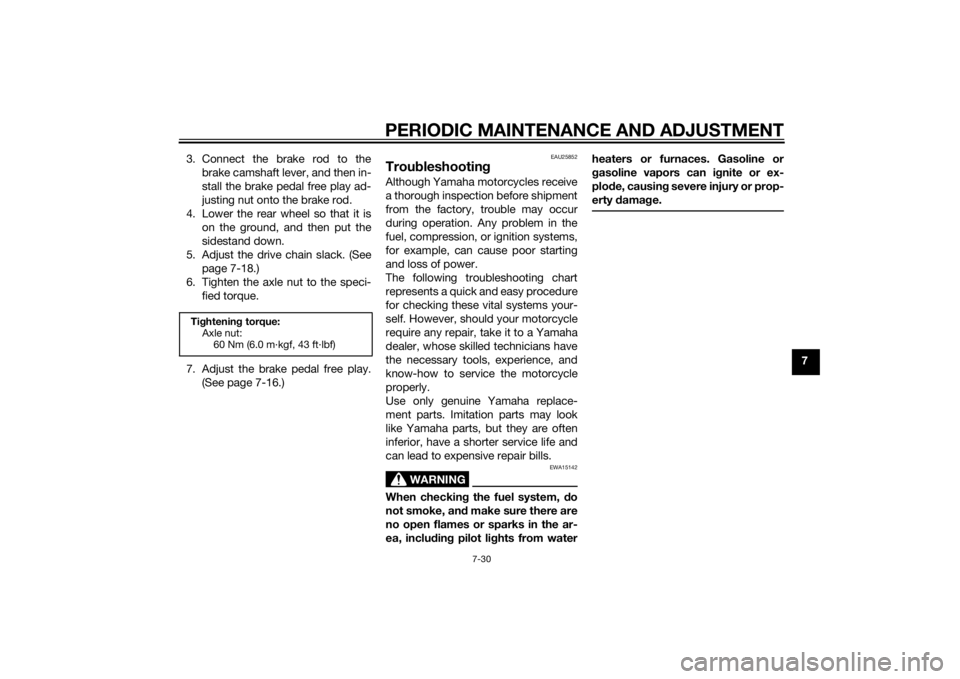
PERIODIC MAINTENANCE AND ADJUSTMENT
7-30
7
3. Connect the brake rod to the
brake camshaft lever, and then in-
stall the brake pedal free play ad-
justing nut onto the brake rod.
4. Lower the rear wheel so that it is on the ground, and then put the
sidestand down.
5. Adjust the drive chain slack. (See page 7-18.)
6. Tighten the axle nut to the speci- fied torque.
7. Adjust the brake pedal free play. (See page 7-16.)
EAU25852
Trou bleshootin gAlthough Yamaha motorcycles receive
a thorough inspection before shipment
from the factory, trouble may occur
during operation. Any problem in the
fuel, compression, or ignition systems,
for example, can cause poor starting
and loss of power.
The following troubleshooting chart
represents a quick and easy procedure
for checking these vital systems your-
self. However, should your motorcycle
require any repair, take it to a Yamaha
dealer, whose skilled technicians have
the necessary tools, experience, and
know-how to service the motorcycle
properly.
Use only genuine Yamaha replace-
ment parts. Imitation parts may look
like Yamaha parts, but they are often
inferior, have a shorter service life and
can lead to expensive repair bills.
WARNING
EWA15142
When checkin g the fuel system, d o
not smoke, an d make sure there are
no open flames or sparks in the ar-
ea, inclu din g pilot li ghts from water heaters or furnaces. Gasoline or
g
asoline vapors can i gnite or ex-
plo de, causin g severe injury or prop-
erty damag e.
Tightenin g torque:
Axle nut: 60 Nm (6.0 m·kgf, 43 ft·lbf)
U2CJ82E0.book Page 30 Monday, June 23, 2014 2:58 PM
Page 74 of 86

PERIODIC MAINTENANCE AND ADJUSTMENT
7-31
7
EAU25905
Troubleshootin g chart
Check the fuel level in
the fuel tank.1. Fuel
There is enough fuel.
There is no fuel.
Check the battery.
Supply fuel.
The engine does not start.
Check the battery.
The engine does not start.
Have a Yamaha dealer check the vehicle.
Operate the electric starter.4. Compression
There is compression.
There is no compression.
Remove the spark plug
and check the electrodes.3. Ignition
Wipe off with a dry cloth and correct the
spark plug gap, or replace the spark plug. Have a Yamaha dealer check the vehicle.
Have a Yamaha dealer check the vehicle.
The engine does not start.
Check the compression.
The engine does not start.
Check the ignition.
Operate the electric starter.2. Battery
The engine turns over
quickly.
The engine turns over
slowly.
The battery is good.Check the battery lead connections,
and have a Yamaha dealer charge
the battery if necessary.
DryWet
Open the throttle halfway and operate
the electric starter.
U2CJ82E0.book Page 31 Monday, June 23, 2014 2:58 PM
Page 75 of 86
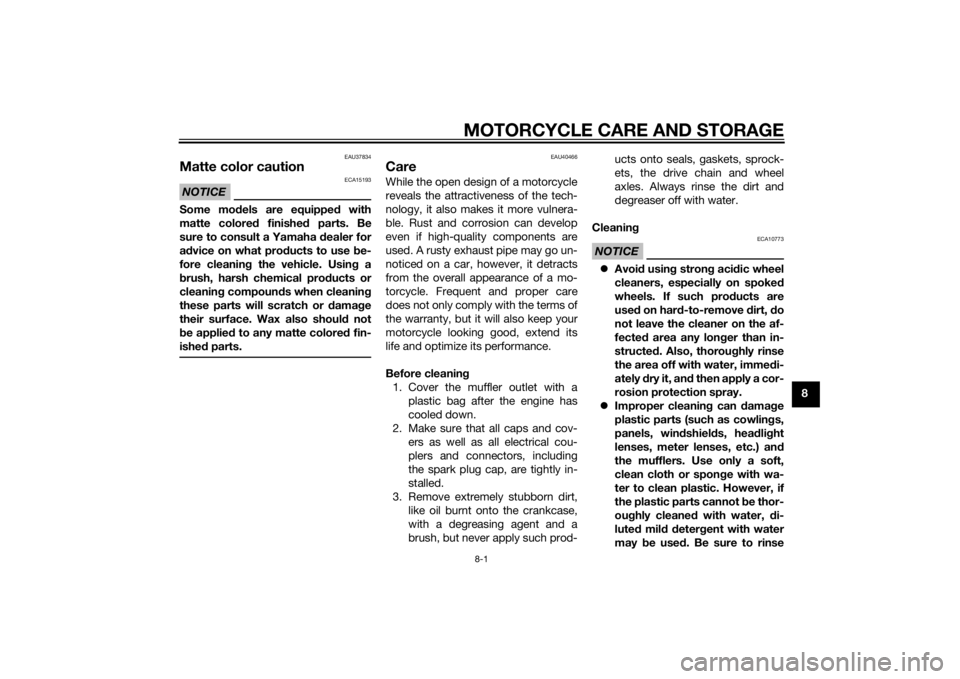
MOTORCYCLE CARE AND STORAGE8-1
8
EAU37834
Matte color cautionNOTICE
ECA15193
Some models are equipped with
matte colored finished parts. Be
sure to consult a Yamaha dealer for
a d vice on what prod ucts to use be-
fore cleanin g the vehicle. Usin g a
b rush, harsh chemical pro ducts or
cleanin g compoun ds when cleanin g
these parts will scratch or damag e
their surface. Wax also shoul d not
b e applie d to any matte colored fin-
ishe d parts.
EAU40466
CareWhile the open design of a motorcycle
reveals the attractiveness of the tech-
nology, it also makes it more vulnera-
ble. Rust and corrosion can develop
even if high-quality components are
used. A rusty exhaust pipe may go un-
noticed on a car, however, it detracts
from the overall appearance of a mo-
torcycle. Frequent and proper care
does not only comply with the terms of
the warranty, but it will also keep your
motorcycle looking good, extend its
life and optimize its performance.
Before cleanin g
1. Cover the muffler outlet with a plastic bag after the engine has
cooled down.
2. Make sure that all caps and cov- ers as well as all electrical cou-
plers and connectors, including
the spark plug cap, are tightly in-
stalled.
3. Remove extremely stubborn dirt, like oil burnt onto the crankcase,
with a degreasing agent and a
brush, but never apply such prod- ucts onto seals, gaskets, sprock-
ets, the drive chain and wheel
axles. Always rinse the dirt and
degreaser off with water.
Cleanin g
NOTICE
ECA10773
Avoi d usin g stron g aci dic wheel
cleaners, especially on spoked
wheels. If such pro ducts are
use d on har d-to-remove dirt, do
not leave the cleaner on the af-
fected area any lon ger than in-
structed . Also, thorou ghly rinse
the area off with water, immed i-
ately dry it, an d then apply a cor-
rosion protection spray.
Improper cleanin g can d amage
plastic parts (such as cowlin gs,
panels, win dshiel ds, hea dlig ht
lenses, meter lenses, etc.) an d
the mufflers. Use only a soft,
clean cloth or spon ge with wa-
ter to clean plastic. However, if
the plastic parts cannot be thor-
ou ghly cleaned with water, di-
lute d mil d d eter gent with water
may be used . Be sure to rinse
U2CJ82E0.book Page 1 Monday, June 23, 2014 2:58 PM
Page 76 of 86

MOTORCYCLE CARE AND STORAGE
8-2
8off any d
etergent resi due usin g
plenty of water, as it is harmful
to plastic parts.
Do not use any harsh chemical
prod ucts on plastic parts. Be
sure to avoi d using cloths or
spon ges which have been in
contact with stron g or a brasive
cleanin g prod ucts, solvent or
thinner, fuel ( gasoline), rust re-
movers or inhi bitors, brake flui d,
antifreeze or electrolyte.
Do not use hi gh-pressure wash-
ers or steam-jet cleaners since
they cause water seepa ge an d
d eterioration in the followin g ar-
eas: seals (of wheel an d swin g-
arm bearin gs, fork an d b rakes),
electric components (couplers,
connectors, instruments,
switches an d lig hts), breather
hoses an d vents.
For motorcycles equippe d with
a win dshield : Do not use stron g
cleaners or har d spon ges as
they will cause dullin g
or
scrat
ching . Some cleanin g
compoun ds for plastic may
leave scratches on the win d- shield
. Test the pro duct on a
small hidden part of the win d-
shield to make sure that it does
not leave any marks. If the win d-
shield is scratche d, use a quality
plastic polishin g compoun d af-
ter washin g.
After normal useRemove dirt with warm water, a mild
detergent, and a soft, clean sponge,
and then rinse thoroughly with clean
water. Use a toothbrush or bottlebrush
for hard-to-reach areas. Stubborn dirt
and insects will come off more easily if
the area is covered with a wet cloth for
a few minutes before cleaning.
After riding in the rain or near the seaSince sea salt is extremely corrosive,
carry out the following steps after each
ride in the rain or near the sea.
1. Clean the motorcycle with cold water and a mild detergent, after
the engine has cooled down.
NOTICE: Do not use warm wa-
ter since it increases the corro-
sive action of the salt.
[ECA10792]
2. Apply a corrosion protection spray on all metal, including chrome-
and nickel-plated, surfaces to pre-
vent corrosion.
After cleanin g
1. Dry the motorcycle with a chamois or an absorbing cloth.
2. Immediately dry the drive chain and lubricate it to prevent it from
rusting.
3. Use a chrome polish to shine chrome, aluminum and stainless-
steel parts, including the exhaust
system. (Even the thermally in-
duced discoloring of stainless-
steel exhaust systems can be re-
moved through polishing.)
4. To prevent corrosion, it is recom- mended to apply a corrosion pro-
tection spray on all metal,
including chrome- and nickel-plat-
ed, surfaces.
5. Use spray oil as a universal clean- er to remove any remaining dirt.
6. Touch up minor paint damage caused by stones, etc.
7. Wax all painted surfaces.
U2CJ82E0.book Page 2 Monday, June 23, 2014 2:58 PM
Page 77 of 86
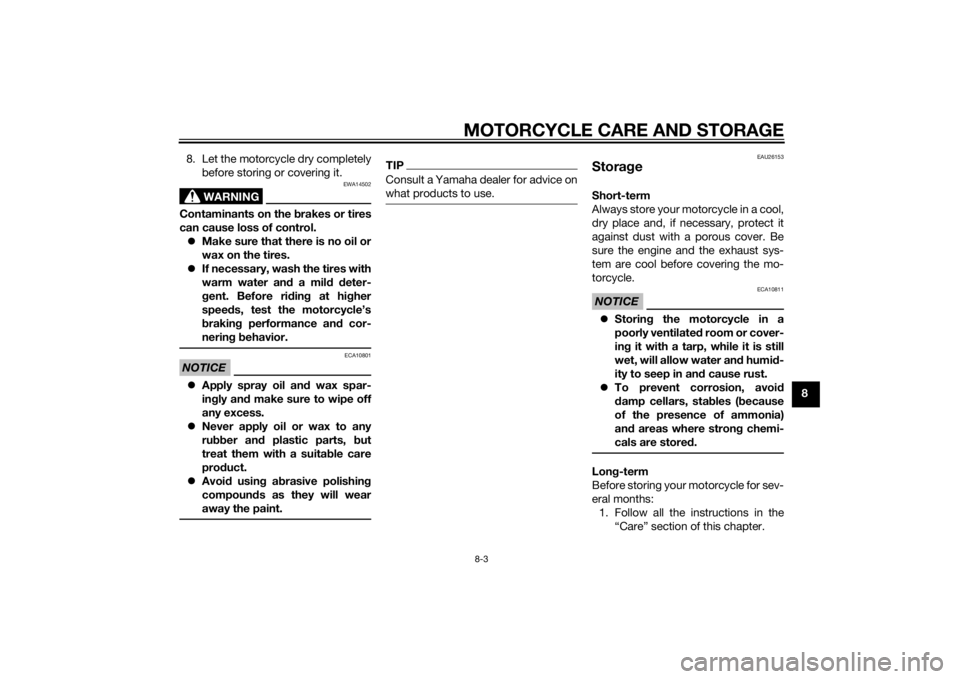
MOTORCYCLE CARE AND STORAGE8-3
8
8. Let the motorcycle dry completely
before storing or covering it.
WARNING
EWA14502
Contaminants on the b rakes or tires
can cause loss of control. Make sure that there is no oil or
wax on the tires.
If necessary, wash the tires with
warm water an d a mil d d eter-
g ent. Before rid ing at hi gher
spee ds, test the motorcycle’s
b rakin g performance an d cor-
nerin g b ehavior.NOTICE
ECA10801
Apply spray oil an d wax spar-
in gly an d make sure to wipe off
any excess.
Never apply oil or wax to any
rubber an d plastic parts, b ut
treat them with a suita ble care
prod uct.
Avoi d usin g a brasive polishin g
compoun ds as they will wear
away the paint.
TIPConsult a Yamaha dealer for advice on
what products to use.
EAU26153
Stora geShort-term
Always store your motorcycle in a cool,
dry place and, if necessary, protect it
against dust with a porous cover. Be
sure the engine and the exhaust sys-
tem are cool before covering the mo-
torcycle.NOTICE
ECA10811
Storin g the motorcycle in a
poorly ventilated room or cover-
in g it with a tarp, while it is still
wet, will allow water an d humi d-
ity to seep in an d cause rust.
To prevent corrosion, avoi d
d amp cellars, stab les (because
of the presence of ammonia)
an d areas where stron g chemi-
cals are stored .Long-term
Before storing your motorcycle for sev-
eral months: 1. Follow all the instructions in the “Care” section of this chapter.
U2CJ82E0.book Page 3 Monday, June 23, 2014 2:58 PM
Page 78 of 86
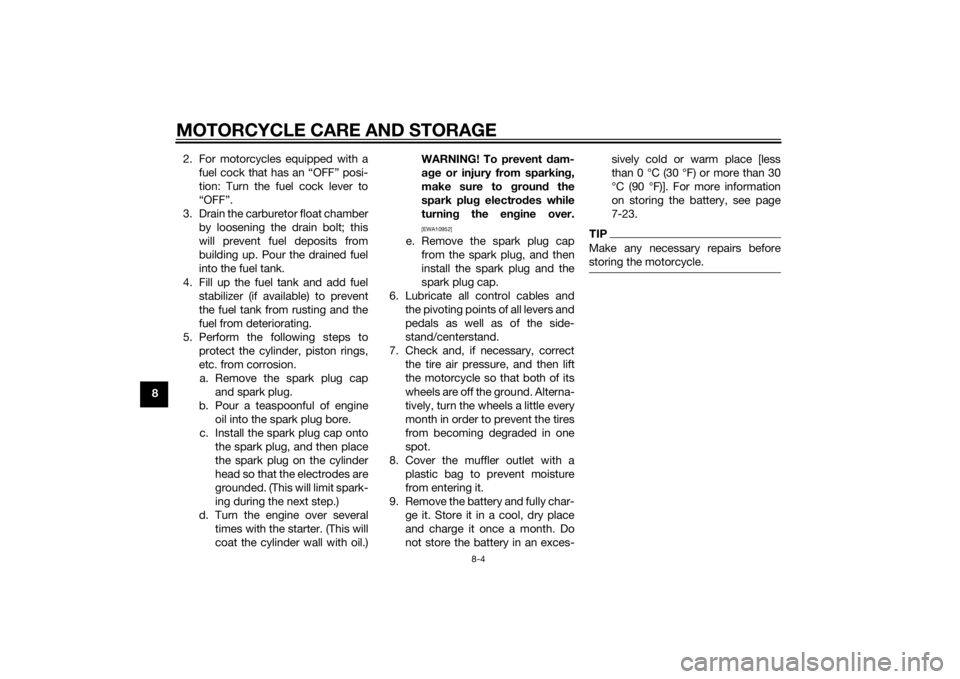
MOTORCYCLE CARE AND STORAGE
8-4
82. For motorcycles equipped with a
fuel cock that has an “OFF” posi-
tion: Turn the fuel cock lever to
“OFF”.
3. Drain the carburetor float chamber by loosening the drain bolt; this
will prevent fuel deposits from
building up. Pour the drained fuel
into the fuel tank.
4. Fill up the fuel tank and add fuel stabilizer (if available) to prevent
the fuel tank from rusting and the
fuel from deteriorating.
5. Perform the following steps to protect the cylinder, piston rings,
etc. from corrosion.a. Remove the spark plug cap and spark plug.
b. Pour a teaspoonful of engine oil into the spark plug bore.
c. Install the spark plug cap onto the spark plug, and then place
the spark plug on the cylinder
head so that the electrodes are
grounded. (This will limit spark-
ing during the next step.)
d. Turn the engine over several times with the starter. (This will
coat the cylinder wall with oil.) WARNING! To prevent d
am-
a g e or injury from sparkin g,
make sure to groun d the
spark plu g electro des while
turnin g the en gine over.
[EWA10952]
e. Remove the spark plug cap
from the spark plug, and then
install the spark plug and the
spark plug cap.
6. Lubricate all control cables and the pivoting points of all levers and
pedals as well as of the side-
stand/centerstand.
7. Check and, if necessary, correct the tire air pressure, and then lift
the motorcycle so that both of its
wheels are off the ground. Alterna-
tively, turn the wheels a little every
month in order to prevent the tires
from becoming degraded in one
spot.
8. Cover the muffler outlet with a plastic bag to prevent moisture
from entering it.
9. Remove the battery and fully char- ge it. Store it in a cool, dry place
and charge it once a month. Do
not store the battery in an exces- sively cold or warm place [less
than 0 °C (30 °F) or more than 30
°C (90 °F)]. For more information
on storing the battery, see page
7-23.
TIPMake any necessary repairs before
storing the motorcycle.
U2CJ82E0.book Page 4 Monday, June 23, 2014 2:58 PM
Page 79 of 86
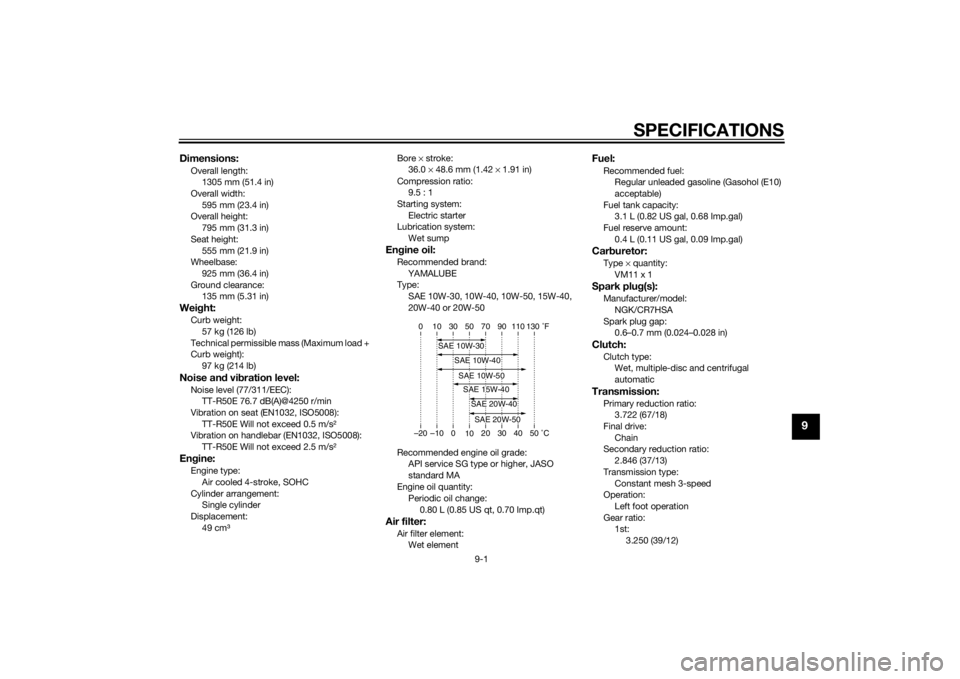
SPECIFICATIONS
9-1
9
Dimensions:Overall length:1305 mm (51.4 in)
Overall width:
595 mm (23.4 in)
Overall height: 795 mm (31.3 in)
Seat height: 555 mm (21.9 in)
Wheelbase:
925 mm (36.4 in)
Ground clearance: 135 mm (5.31 in)Wei ght:Curb weight:
57 kg (126 lb)
Technical permissible mass (Maximum load +
Curb weight):
97 kg (214 lb)Noise an d vi bration level:Noise level (77/311/EEC):
TT-R50E 76.7 dB(A)@4250 r/min
Vibration on seat (EN1032, ISO5008):
TT-R50E Will not exceed 0.5 m/s²
Vibration on handlebar (EN1032, ISO5008): TT-R50E Will not exceed 2.5 m/s²Engine:Engine type:
Air cooled 4-stroke, SOHC
Cylinder arrangement: Single cylinder
Displacement: 49 cm³ Bore
× stroke:
36.0 × 48.6 mm (1.42 × 1.91 in)
Compression ratio: 9.5 : 1
Starting system:
Electric starter
Lubrication system: Wet sump
Engine oil:Recommended brand:
YAMALUBE
Type: SAE 10W-30, 10W-40, 10W-50, 15W-40,
20W-40 or 20W-50
Recommended engine oil grade: API service SG type or higher, JASO
standard MA
Engine oil quantity: Periodic oil change:
0.80 L (0.85 US qt, 0.70 Imp.qt)Air filter:Air filter element:Wet element
Fuel:Recommended fuel:Regular unleaded gasoline (Gasohol (E10)
acceptable)
Fuel tank capacity: 3.1 L (0.82 US gal, 0.68 Imp.gal)
Fuel reserve amount:
0.4 L (0.11 US gal, 0.09 Imp.gal)Car buretor:Type × quantity:
VM11 x 1Spark plu g(s):Manufacturer/model:
NGK/CR7HSA
Spark plug gap: 0.6–0.7 mm (0.024–0.028 in)Clutch:Clutch type:Wet, multiple-disc and centrifugal
automaticTransmission:Primary reduction ratio:3.722 (67/18)
Final drive:
Chain
Secondary reduction ratio: 2.846 (37/13)
Transmission type: Constant mesh 3-speed
Operation:
Left foot operation
Gear ratio: 1st:
3.250 (39/12)
–20 –10 0 1020 30 40 50 �C
10 30 50 70 90 110
0 130 �F
SAE 10W-30
SAE 15W-40SAE 20W-40SAE 20W-50
SAE 10W-40SAE 10W-50
U2CJ82E0.book Page 1 Monday, June 23, 2014 2:58 PM
Page 80 of 86

SPECIFICATIONS
9-2
9
2nd:1.736 (33/19)
3rd: 1.217 (28/23)
Chassis:Frame type:Backbone
Caster angle: 25.50 °
Trail:
34 mm (1.3 in)Front tire:Type:With tube
Size:
2.50-10 4PR
Manufacturer/model: CHENG SHIN/C183A
Speed rating: 100 km/h (62 mph)Rear tire:Type:With tube
Size: 2.50-10 4PR
Manufacturer/model:
CHENG SHIN/C183A
Speed rating: 100 km/h (62 mph)Loa din g:Maximum rider weight:
40.0 kg (88 lb)
Tire air pressure (measure d on col d
tires):
Front:
100 kPa (1.00 kgf/cm², 15 psi)
Rear: 100 kPa (1.00 kgf/cm², 15 psi)
Front wheel:Wheel type:
Spoke wheel
Rim size: 10x1.40Rear wheel:Wheel type:
Spoke wheel
Rim size: 10x1.40Front brake:Type:
Drum brake
Operation: Right hand operationRear brake:Type:
Drum brake
Operation: Right foot operationFront suspension:Type:
Telescopic fork
Spring/shock absorber type: Coil spring
Wheel travel: 96 mm (3.8 in)
Rear suspension:Type:Swingarm
Spring/shock absorber type:
Coil spring/oil damper
Wheel travel: 71 mm (2.8 in)Electrical system:Ignition system:
DC CDI
Charging system: AC magnetoBattery:Model:
GT4B-5
Voltage, capacity: 12 V, 2.5 AhFuse:Fuse:
10.0 A
U2CJ82E0.book Page 2 Monday, June 23, 2014 2:58 PM